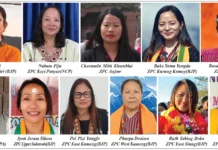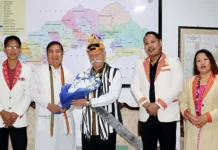[Tadup Tana Tara]
Nabam Regum’s review of my book, 75 Years of Legal Evolution: Arunachal Pradesh Path From AFR to Civil Courts Act, prompted an unexpected scholarly challenge. His 3 July social media post, written in his capacity as president of the Papum Pare District Bar Association, highlighted a glaring gap in constitutional scholarship – Article 371H – and urged immediate academic attention to this provision governing Arunachal Pradesh’ special status.
His appeal turned the upcoming high court vacation into a research opportunity. What started as preliminary notes has grown into the foundation for what may become a significant contribution to constitutional jurisprudence, filling a gap that has existed far too long.
The Indian Constitution recognizes the unique character of the Northeastern states through specific provisions addressing indigenous communities’ distinct needs and rights. Articles 371A, 371G, and 371H represent the most significant of these provisions, creating legal frameworks that foster autonomy while preserving tribal culture and identity. Examining these articles reveals their individual provisions, broader implications, and interconnections – particularly relevant to understanding Arunachal’s constitutional position.
The Indian Constitution has historically recognized the unique demographic and cultural composition of its Northeastern states through provisions designed to address the distinct needs and rights of indigenous communities. Among these provisions, Articles 371A, 371G, and 371H stand out as they offer a legal framework aimed at fostering autonomy and preserving the culture and identity of tribal populations. By examining these articles, a clearer understanding of their respective provisions, implications, and interconnections can be established, particularly within the context of Arunachal.
Article 371A is primarily specific to Nagaland. Enacted to protect the customs and traditions of the Naga people, this article grants the state the authority to legislate on land ownership and management of natural resources while underscoring that the legislative assembly of Nagaland will not have the authority to impose laws in the context of land use or religious practices that are not congruent with the traditions of the Naga tribes. This degree of autonomy over land and culture is pivotal for the Nagas, who view land as integral to their identity.
Additionally, Article 371A underscores the significance of customary laws and the protection of the rights of indigenous people, ensuring that their historical and cultural practices are preserved without external interference.
In sharp contrast, Article 371G applies specifically to Mizoram. Similar to Article 371A, it also focuses on safeguarding the cultural identity of the Mizo people. It bestows upon the Mizoram legislative assembly the power to regulate and legislate in matters, including land ownership and customs, thereby reinforcing the idea that any laws impinging on their cultural practices need consensus from the local populace. This legislative power extends to the management of key resources and customary laws, reflecting a similar ethos found in Nagaland while offering its unique safeguards based on Mizo customs. For the Mizo people, the article has played a critical role in maintaining their cultural integrity amidst broader national policies that may not always align with their practices.
Article 371H is unique to Arunachal and aims to protect the state’s cultural identity while also interpreting specific roles for governance and autonomy. It designates the state assembly with the power to legislate on issues relating to land and resources, alongside establishing a representative body for local governance. However, unlike its counterparts in Nagaland and Mizoram, Article 371H does not afford similar comprehensive autonomy over customary practices. Instead, it somewhat integrates local governance mechanisms within the broader framework of state governance. This autonomy is crucial in a region widely noted for its diversity of tribes and languages, which necessitates tailored governance practices to ensure effective representation and protection of indigenous rights. However, the nuances in the execution and interpretation of Article 371H have led to community concerns regarding its efficacy in granting true autonomy.
Examining the distinct features of these articles reveals not only their individual strengths but also the overlapping themes that bind them together. At the core of each is the recognition of indigenous customs and the emphasis on preserving cultural integrity within respective governance frameworks. Articles 371A and 371G place considerable emotional and legal weight on land and its cultural significance for the respective tribes. In this regard, one can say that these articles echo the unwavering tribal sentiment linking land to identity, heritage, and autonomy. The safeguarding of natural resources through legislation has been recognized as a necessity for indigenous communities, fostering a sense of ownership and enabling self-determination.
Despite these apparent similarities, a critical analysis also reveals considerable disparities in the scope and implementation of these articles. While Articles 371A and 371G afford a high degree of legislative power and autonomy to the respective assemblies, Article 371H faces challenges with regard to its practical implications. The degree of local political engagement and administrative effectiveness in Arunachal often highlights limitations encumbering Article 371H. For instance, many governance functions, including land management, are still largely influenced by broader state directives that sometimes overlook local customs and practices, leading to frustration among the indigenous population.
In analyzing the broader legal comparison across Articles 371A, 371G, and 371H, one can identify critical mechanisms for addressing indigenous rights and cultural preservation. The persistence of community-driven advocacy in Nagaland and Mizoram has fostered political environments conducive to dialogue on rights and autonomy. In contrast, the governance disharmony in Arunachal, marked by the unsynchronized interplay of local customs and state policies, reveals a lack of representation in decisions affecting land rights and cultural practices. Therefore, the effectiveness of each article hinges not merely on its legislative wording but also on its practical application and the participatory channels available for communities to voice their needs.
The socio-political narratives behind these legal frameworks also garner significance when exploring their distinct features. In Nagaland and Mizoram, the storied legacies of conflict, negotiation, and eventual state integration have shaped tailored needs for autonomy reflected in their articles. On the contrary, Arunachal’s greater challenge lies in the diverse demographic composition of tribal groups, rendering broader negotiations on cultural rights and resource management more complex. Herein lies the essence of the differences, where Articles 371A and 371G leverage narrower cultural identities to create legislative provisions, while Article 371H navigates through a diverse unity comprising multiple tribes.
The intersection of culture, law, and governance facilitates opportunities for enhanced representation among indigenous populations. As seen in Articles 371A and 371G, the empowerment of local assemblies to regulate on culturally pertinent matters has legitimized tribal governance structures and led to a cohesive path towards self-determination. The strengths of these model articles can serve as instructional lenses through which Article 371H can pursue reform, elevating tribal voices within the legal framework of Arunachal.
Engagement with civil society actors and grassroots organizations is essential to recalibrate the balance of rights and governance under Article 371H. The assertive incorporation of community feedback into legal frameworks enables the creation of synergistic alliances across political, legal, and social dimensions. Additionally, continued advocacy and legal mobilization have proved impactful in other states, potentially serving as a constructive foundation for Arunachal.
Future deliberations concerning the autonomy and rights of indigenous communities across the Northeastern states might benefit by conceptualizing these articles not as isolated legal entities but as components of a continuum that seeks to strengthen indigenous representation. This perspective underscores a moratorium on comparing disparate governance frameworks toward creating a collaborative discourse around inclusivity and collective rights across tribal populations.
For easier understanding, a comparison of Articles 371(A), 371 (G) and 371 (H) is shown below in the table:
| Provision | Nagaland (371A) | Mizoram (371G) | Arunachal Pradesh(371H) |
| Customary Law | Protected | Protected | Not Protected |
| Land Rights | Protected | Protected | Not Protected |
| Religious Practice | Protected | Protected | Not Protected |
| Governor’s Powers | No | No | Yes (Law & order |
In summary, while Articles 371A, 371G, and 371H serve as specific legislative instruments aimed at addressing the cultural rights and autonomy of indigenous peoples, their study opens a broader dialogue about governance, representation, and the footprints of legal interpretation. The value of these articles is demonstrated in their ability to adapt alongside the evolving aspirations of tribal communities, making the case for adaptive governance models through inclusive policy mechanisms. (The author currently serves as president of the Gauhati High Court, Itanagar Permanent Bench Bar Association. He can be contacted at tttara2008@gmail.com)




